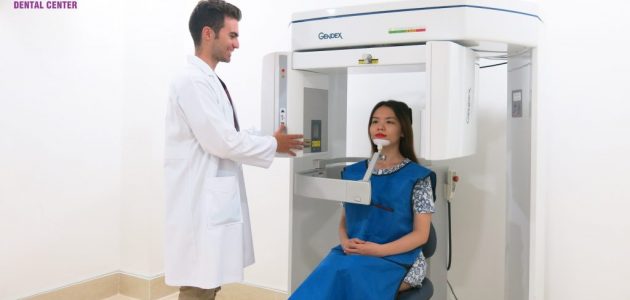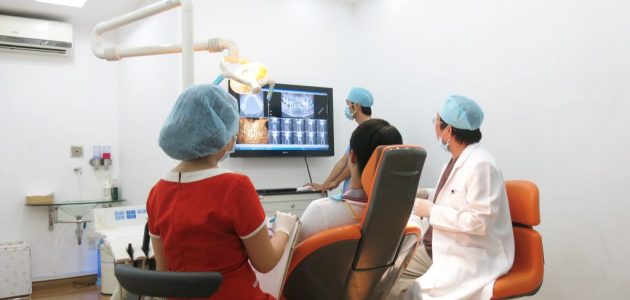Overview
Wisdom tooth extraction is a surgical procedure to remove one or more wisdom teeth — the four permanent adult teeth located at the back corners of your mouth on the top and bottom.
If a wisdom tooth doesn’t have room to grow (impacted wisdom tooth), this would result in pain, infection or other dental problems. You’ll need to have it pulled. Wisdom tooth extraction may be done by a dentist or an oral surgeon.
To prevent potential future problems, some dentists and oral surgeons recommend wisdom tooth extraction even if impacted teeth aren’t currently causing problems.
Why is wisdom tooth extraction necessary?
Wisdom teeth, or third molars, are the last permanent teeth to appear (erupt) in the mouth. These teeth usually appear between the ages of 17 and 25. Some people never have wisdom teeth. For others, wisdom teeth erupt normally — just as their other molars did — and cause no problems.
Many people develop impacted wisdom teeth — teeth that don’t have enough room to erupt into the mouth or develop normally. Impacted wisdom teeth may erupt only partially or not at all.

An impacted wisdom tooth may:
- Grow at an angle toward the back of the mouth
- Grow at an angle toward the next tooth (second molar)
- Grow at a right angle to the other teeth, as if the wisdom tooth is “lying down” within the jawbone
- Grow straight up or down like other teeth but stay trapped within the jawbone
Problems with impacted wisdom teeth
You’ll need your impacted wisdom tooth pulled if it results in problems such as:
- Pain
- Trapping food and debris behind the wisdom tooth
- Infection or gum disease (periodontal disease)
- Tooth decay in a partially erupted wisdom tooth
- Damage to a nearby tooth or surrounding bone
- Development of a fluid-filled sac (cyst) around the wisdom tooth
- Complications with orthodontic treatments to straighten other teeth

Preventing future dental problems
Dental specialists disagree about the value of extracting impacted wisdom tooth that isn’t causing problems (asymptomatic).
It’s difficult to predict future problems with impacted wisdom teeth. However, here’s the rationale for preventive extraction:
- Symptom-free wisdom tooth could still harbor disease.
- If there isn’t enough space for the tooth to erupt, it’s often hard to get to it and clean it properly.
- Serious complications with wisdom tooth happen less often in younger adults.
- Older adults may experience difficulty with surgery and complications after surgery.
Risks
Most wisdom tooth extractions generally don’t result in complications. However, removal of impacted wisdom tooth occasionally requires a surgical approach that involves making an incision in the gum tissue and removing bone. Rarely, complications can include:
- Painful dry socket, or exposure of bone when the post-surgical blood clot is lost from the site of the surgical wound (socket)
- Infection in the socket from bacteria or trapped food particles
- Damage to nearby teeth, nerves, jawbone or sinuses
How you prepare
Your dentist may perform the procedure in the office. However, if your tooth is deeply impacted or if the extraction requires an in-depth surgical approach, your dentist may suggest you see an oral surgeon. In addition to making the area numb with local anesthetic, your surgeon may suggest sedation to allow you to be more comfortable during the procedure. At Dr. Hung & Associates Dental Center, we are fully equipped with different types of anesthesia care to ensure you feel no pain during the procedure.
Questions to ask
Questions you may want to ask your dentist or oral surgeon include:
- How many wisdom teeth need to be removed?
- What type of anesthesia will I receive?
- How complicated do you expect the procedure to be?
- How long is the procedure likely to last?
- Have the impacted wisdom teeth caused damage to other teeth?
- Is there a risk that I might have nerve damage?
- What other dental treatments might I need at a later date?
- How long does it take to completely heal and return to normal activity?
Preparing for surgery
A wisdom tooth extraction is almost always performed as an outpatient procedure. This means that you go home the same day.
You’ll receive instructions from the hospital or dental clinic staff on what to do before the surgery and the day of your scheduled surgery. Ask these questions:
- Will I need to make arrangement for someone to drive me home after the procedure?
- When do I need to arrive at the dental clinic or hospital?
- Do I need to avoid eating food or drinking fluids or both (fast)? If so, when do I begin?
- Can I take my prescription medications before the surgery? If so, how soon before the surgery can I take a dose?
- Should I avoid any nonprescription drugs before the surgery?
What you can expect during the procedure
Our doctors may use one of three types of anesthesia, depending on the expected complexity of the wisdom tooth extraction and your comfort level. Options include:
- Local anesthesia. The doctor administers local anesthesia with one or more injections near the site of each extraction. Before you receive an injection, the doctor will likely apply a substance to your gums to numb them. You’re awake during the tooth extraction. Although you’ll feel some pressure and movement, you shouldn’t experience pain.
- Sedation anesthesia. The doctor gives you sedation anesthesia through an intravenous (IV) line in your arm. Sedation anesthesia suppresses your consciousness during the procedure. You don’t feel any pain and will have limited memory of the procedure. You’ll also receive local anesthesia to numb your gums.
- General anesthesia. In special situations, you may be offered general anesthesia. You may inhale medication through your nose or have an IV line in your arm, or both. Then you lose consciousness. Our surgical team closely monitors your medication, breathing, temperature, fluids and blood pressure. You’ll experience no pain and have no memory of the procedure. Local anesthesia is also given to help with postoperative discomfort.
During wisdom tooth extraction, our doctor will:
- Make an incision in the gum tissue to expose the tooth and bone
- Remove bone that blocks access to the tooth root
- Divide the tooth into sections if it’s easier to remove in pieces
- Remove the tooth
- Clean the site of the removed tooth of any debris from the tooth or bone
- Stitch the wound closed to promote healing, though this isn’t always necessary
- Place gauze over the extraction site to control bleeding and to help a blood clot form
After the procedure
If you receive sedation anesthesia or general anesthesia, you’re taken to a recovery room after the procedure. If you have local anesthesia, your brief recovery time is likely in the dental chair.
As you heal from your surgery, follow the doctor’s instructions on:
- Bleeding. Some oozing of blood may occur the first day after wisdom tooth removal. Try to avoid excessive spitting so that you don’t dislodge the blood clot from the socket. Replace gauze over the extraction site as directed by your dentist or oral surgeon.
- Pain management. You may be able to manage pain with an over-the-counter pain reliever, such as acetaminophen (Tylenol, others), or a prescription pain medication from your dentist or oral surgeon. Prescription pain medication may be especially helpful if bone has been removed during the procedure. Holding a cold pack against your jaw also may relieve pain.
- Swelling and bruising. Use an ice pack as directed by your dentist or surgeon. Any swelling of your cheeks usually improves in two or three days. Bruising may take several more days to resolve.
- Activity. After your surgery, plan to rest for the remainder of the day. Resume normal activities the next day, but for at least a week, avoid strenuous activity that might result in dislodging the blood clot from the socket.
- Beverages. Drink lots of water after the surgery. Don’t drink alcoholic, caffeinated, carbonated or hot beverages in the first 24 hours. Don’t drink with a straw for at least a week because the sucking action can dislodge the blood clot from the socket.
- Food. Eat only soft foods, such as yogurt or applesauce, for the first 24 hours. Start eating semisoft foods when you can tolerate them. Avoid hard, chewy, hot or spicy foods that might get stuck in the socket or irritate the wound.
- Cleaning your mouth. Don’t brush your teeth, rinse your mouth, spit or use mouthwash during the first 24 hours after surgery. Typically you’ll be told to resume brushing your teeth after the first 24 hours. Be particularly gentle near the surgical wound when brushing and gently rinse your mouth with warm salt water every two hours and after meals for a week.
- Tobacco use. If you smoke, don’t do so for at least 72 hours after surgery — and wait longer than that if possible. If you chew tobacco, don’t use it for at least a week. Using tobacco products after oral surgery can delay healing and increase the risk of complications.
- Stitches. You may have stitches that dissolve within a few weeks or no stitches at all. If your stitches need to be removed, schedule an appointment to have them taken out.
When to call your dentist or surgeon
Call your dentist or oral surgeon if you experience any of the following signs or symptoms, which could indicate an infection, nerve damage or other serious complication:
- Difficulty swallowing or breathing
- Excessive bleeding
- Fever
- Severe pain not relieved by prescribed pain medications
- Swelling that worsens after two or three days
- A bad taste in your mouth even after saltwater rinsing
- Pus in or oozing from the socket
- Persistent numbness or loss of feeling
- Blood or pus in nasal discharge
Results
You probably won’t need a follow-up appointment after a wisdom tooth extraction if:
- You don’t need stitches removed
- No complications arose during the procedure
- You don’t experience persistent problems, such as pain, swelling, numbness or bleeding — complications that might indicate infection, nerve damage or other problems
If complications develop, contact your dentist or oral surgeon to discuss treatment options.
What are the advantages of getting your impacted wisdom teeth removed at Dr. Hung & Associates Dental Center?
Getting your wisdom teeth removed at Dr. Hung & associates dental Center will bring you many benefits, which result from our doctor’s experience, the modern equipments and absolutely microbial-free environment provided during surgery. We offer:
- 3D Cone-beam CT Scan preoperatively, which will give our doctor a precise view of the impacted tooth and how to get it removed as quick and atraumatic as possible
- Piezoelectric surgery machine, which uses ultrasonic power for to cut through the tooth, in order to decrease trauma to other kinds of tissue and thus, accelerate the healing process post operation
- Sedative anesthesia or general anesthesia, controlled by our experienced anesthesiologists. Under sedative anesthesia or general anesthesia, you will feel relaxed during and after the procedure. We can carry out the removal of all 4 wisdom teeth in one appointment, which helps save you time.
| Bone Graft | 200-300/unit | 259-389/unit | 178-268/unit |
| Membrane Graft | 100-200/unit | 129 – 259/ unit | 89 – 178/ unit |
| Sinus Lift | 500-800/one side | 648-1037/one side | 447-715/one side |
| Teeth Lengthening | 100/unit | 129/unit | 89/unit |
| Frenectomy | 325/case | 421/ case | 290/ case |
| Cosmetic Gum Surgery Bone Reduced (if needed) |
100/tooth 100/tooth |
129/ tooth 129/ tooth |
89/ tooth 89/ tooth |
| Gum Graft | 300 – 350/unit | 389 – 453/ unit | 268 – 313/ unit |
| Apicoectomy Surgery | 75-150/unit | 97-194/unit | 67-134/unit |
| Tooth extraction | 50/tooth | 64/ tooth | 44/ tooth |
| Atraumatic Extraction by Piezo machine | 100-150/unit | 129 – 194/ unit | 89 – 134/ unit |
| Atraumatic Extraction by Piezo machine for wisdom tooth/ impacted tooth |
150-250/unit | 194-324/unit | 134-223/unit |
| Surgery for bimaxillary protrusion wassmund and kole procedure | 4200 – 4500/case | 5444 – 5832/ case | 3755 – 4023/ case |
| Bilateral sagittal split osteotomy | 3000-4500/case | 3888 – 5832/case | 2682 – 4023/ case |
| Orthognatic surgery and jaw contouring | 5000/ lower jaw | 6481/ lower jaw | 4470/ lower jaw |
| Orthognatic surgery (both jaws) + jaw contouring | 7000/case | 9073 / case | 6259/ case |
| Mandibular bilateral sagittal split osteotomy | 2500 – 3500/case | 3240 – 4536/ case | 2235 – 3129/ case |
| Mandibular angle reduction/oval/V-line | 3500 – 4500/ case | 4536 – 5832/ case | 3129 – 4023/ case |
| Mandible nerve repositioning surgery | Enquire | Enquire | Enquire |
